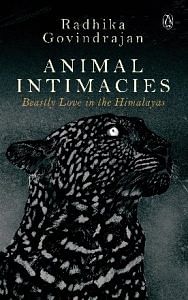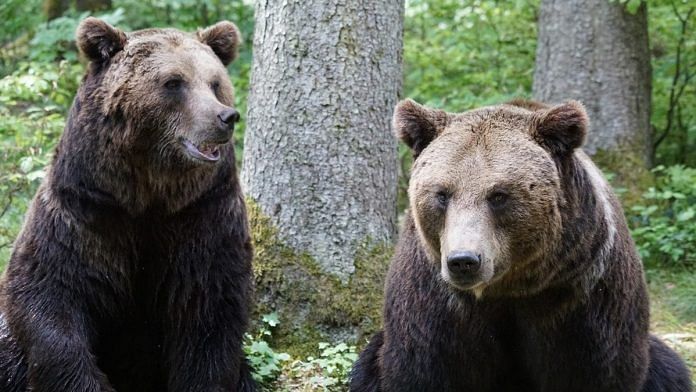“Really?” I asked.
“Yes, they say her husband wasn’t nice. Maybe the bear was a better husband.”
***
These were women’s stories, but they were also stories about bestiality that called the boundary between human and animal into question. As such, they raised compelling questions not just about women’s lives and desires but also about interspecies relationships.
What about bears made them the choice for partner in this carnal interspecies encounter? How did the lustful bears of these stories relate to “real” bears, the Himalayan black bear that roamed the forests of this region? How did bears come to be related to women as husbands? What, in particular, was it about embodied interspecies encounters between women and bears that allowed for the queer boundary crossing — between human and animal, between mundane and extraordinary, between drudgery and love — that is at the heart of this genre?
In working through the answers to these questions over the rest of this chapter, I follow Ann Gold who asserts that women’s stories and the demands and desires articulated through them should not be falsely separated from “the social universe that produces them year-round and also values them.” The critical analytical and empirical frameworks that I offer the reader draw on my commitment to situating these tellings firmly in the particular social world in which they came to life. I take these tellings as attempts to imagine and enact alternate ways of dwelling and connecting in a world where one exists only in relation to a variety of human and nonhuman others.
These tellings not only have implications for understanding how women pose themselves as sexual subjects in a social world that frowns on feminine expressions of desire but also point to the ways in which feminist perspectives can be enriched by moving beyond the limitations of an anthropocentric approach to understanding women’s consciousness and considering how human subjectivity, in general, is crucially formed in relation to the nonhuman world.
Bhalu ki baat
Bears are favored creatures of cultural lore and practice. In legends, songs, and ceremonies of the Northern Hemisphere, they appear most often as sacred, powerful, mysterious, and sagacious characters. For instance, Native American legends about bears abound and represent them as spiritual guardians of the forest who are able to speak with humans and establish kinship with them. In comparison, bears do not command as rich a folklore in India.
There are scattered references to bears in folktales around the country, although they figure in these mostly as incidental characters. Where they appear as major characters, such as in one of the Jataka tales, bears are characterized as greedy animals who suffer as a result of being unable to curb their appetites. There is also, of course, the famous anthropomorphized army of bears led by Jambavan that joins Hanuman to help Rama defeat the king of Lanka, Ravana, in the Ramayana.
On the whole, though, especially when compared with other animals such as monkeys or snakes, bears make relatively rare appearances in South Asian lore. The genre of stories I describe in this chapter are, therefore, quite unusual in their selection of animal protagonist. Given their close resemblance to humans, however, it is perhaps unsurprising that bears are the natural choice for stories about animals who have sex with women. As Wendy Doniger points out, it is our feet, the “sign of our human condition.” that are thought to separate us from animals. However, bears’ occasional bipedalism transgresses that boundary of the foot in evocative ways.
Stories about women being abducted by and having sex with bears or anthropoid creatures bearing close resemblance to bears have long circulated across the Himalayan region. In the 1889 shikar narrative Hindu-Koh: Wandering and Wild Sport on and beyond the Himalayas, Donald Macintyre, a colonial hunter, noted that “fables innumerable about bears” are common among paharis in Kumaon. He writes that these tales are “often amusing from their utter absurdity.” As an example of one such fable, he says that “the occasional abduction of women from the villages by bears is firmly believed in.”
In Nepal and Tibet, the wild man figure of the Yeti, who was believed to abduct women and have sex with them, has become an icon of popular culture since his mysterious traces in these mountains first fascinated generations of colonial officials and European travelers. Some have suggested that the Yeti is simply a representation of people’s experience with bears, either the Asiatic black bear or the brown bear (sometimes called lal bhalu, or red bear). In an interesting gender inversion of both the Kumaoni genre and the Yeti stories, Tamang villagers in Nepal believe that the nyalmo, a female anthropoid creature, abducts men and holds them captive, even bearing their children.
Tales of bestiality with bears also abound in medieval Europe. Bears were thought to be lustful creatures, obsessed with seeking carnal pleasure. Bieder notes that Saint Damian reminded the flock of the bear’s carnal nature when he told them that Pope Benedict had been turned into a bear in the afterlife as a consequence of his lustfulness on earth.
Indeed, it was the lusty nature of bears that was foregrounded in reports of their abduction of young women. Edward Topsell, in his famous The Historie of Foure-Footed Beastes, noted that bears were of a “most venereous and lustful disposition.” He shared a story of a “young maid” in Savoy who was carried by a bear into his den, “where in venereous manner he had the carnal use of her body and while he kept her in his den, he daily went forth and brought her home the best Apples and other fruits he could get . . . always when he went to forrage, he rouled a huge great stone upon the mouth of his den.” Topsell also described the copulation behavior of bears, saying that “the manner of their copulation is like to a mans, the male moving himself upon the belly of the female, which lyeth on the earth flat upon the back.”
Topsell’s account, in particular, bears striking similarity to the tellings that I heard in contemporary Kumaon—there is the stone that the bear rolls in front of the cave, the little detail about bears copulating like men in the missionary position, the gifts of food, and the general characterization of the bear as a lustful creature obsessed with carnal fulfillment. But what does one call these accounts? Initially I persisted in calling them folktales, even after Bimla di’s pointed rebuke that she was recounting to me a “true” event. But my characterization of this genre as one of folktales was resisted by all the women who told me of these “events”; this was sach (true), they insisted, not an illocutionary kahani (tales), a claim they backed up by specifying that these were events that had occurred in the recent past in nearby villages.
 This excerpt from the 2019 book ‘Animal Intimacies’ has been published with permission from the publisher Penguin Viking.
This excerpt from the 2019 book ‘Animal Intimacies’ has been published with permission from the publisher Penguin Viking.




